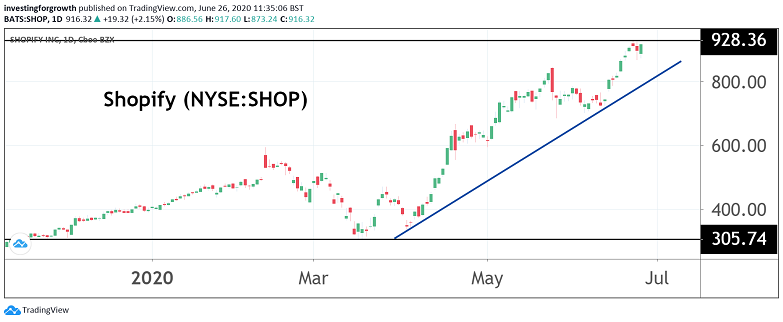Stockwatch: is this star share with massive potential a buy?
Here’s what our value-conscious analyst thinks of this share which has tripled in value since March.
26th June 2020 12:55
by Edmond Jackson from interactive investor
Here’s what our value-conscious analyst thinks of this share which has tripled in value since March.

Shopify (NYSE:SHOP) exemplifies how some of the most dynamic growth companies – with ability to go global – are found among US-listed stocks.
The company’s software hosting enables anyone to set up an online store, hence has become a crucial means, for small to mid-size businesses especially, to maintain contact with their customers through Covid-19.
It is not an e-commerce marketplace like Amazon (NASDAQ:AMZN); instead, it derives revenues from maintaining online store fronts and analysing trade.
It partners with social media firms such as Facebook (NASDAQ:FB) and other online platforms including Walmart whose online sales have recently overtaken eBay (NASDAQ:EBAY).
Not surprisingly then, its stock has soared with the help of the pandemic: up over 120% this year versus about 2% for roller coaster Walmart (NYSE:WMT). At around $915 currently, Shopify is capitalised near $110 billion (£88.5 billion) or 69x 2019 revenue of near $1.6 billion.
Buyers are most likely attracted by income statements (see table below) showing rapid revenue growth: up 47% in 2019 alone, and hardly from a small base.
Momentum was established well before Covid-19 and is now re-rating sales substantially further.
It may be that investors regard the shares as a hedge, perhaps against other companies that might issue warnings if the US fails to contain Covid-19 and restrictions beckon again.
A tipping point into meaningful profits remains elusive
The first quarter 2020 results maintained a 47% like-for-like revenue trend and adjusted gross profit rose 44% to $263.8 billion. The operating loss more than doubled to $73.2 million or $7.3 million on an adjusted basis, versus a $0.3 million operating profit like for like.
As a software group that’s nowadays acquisitive, Shopify amortises intangibles, and a stock compensation scheme also explains the adjusted differential.
But, as the annual income statement summary shows, R&D and admin costs have so far tended to grow with revenue.
Shopify’s growth is, however, underwritten by $2.4 billion of cash at end-March, allowing traders to conjure a sense that this could be the software equivalent of Amazon, which itself was frequently criticised in earlier years for not making profits, yet in due course they came through powerfully.
- Apple: how the world’s biggest company can get much bigger
- US stock market at potentially dangerous inflection point
- Want to buy and sell international shares? It’s easy to do. Here’s how
The difficulty of making even vaguely reliable forecasts, until there’s a net profits track record, has likely benefited the stock which has trebled since a February/March drop from $593 to $305 – now up at a record $928.
And yet the 6 May outlook statement was blasé in the sense of suspending any guidance, even in terms of confidence whether Shopify is likely to benefit overall from the pandemic as consumers switch spending online.
Management was monitoring the effect of rising unemployment on new shop creation on the platform, plus patterns of consumer spending and the ability of brick-and-mortar retail to shift sales online.
It’s as if the short to medium-term underlying trend is more complex than recent momentum buyers assumed.
Yet the stock’s rise is likely down to additional ‘risk money’ in circulation seeking a home, and the new cohort of traders-in-furlough, driven by chart momentum.

Source: TradingView. Past performance is not a guide to future performance.
An emerging multinational even so
Shopify was founded 16 years ago in Ottawa, Canada and remains headquartered there. Mind, it took less than 10 years for Amazon to break into profits, enjoying a better pivot point.
Starting via an online store for snowboarding equipment, the Shopify platform was launched mid-2006 and, in 2010, a free app via the Apple store enabled store owners to operate over mobile devices.
Community progression was helped by a Build-A-Business competition quite like Dragons Den, start-ups on the platform being mentored by entrepreneurs such as Richard Branson.
Vertical integration then followed with the help of venture capital in acquiring a mobile software developer and a design studio.
In 2013, Shopify introduced a payments system enabling merchants to accept credit cards without requiring a third party payment gateway.
Its number of online retailers has soared from 120,000 in 2014 over 1 million last year (but was not updated in May’s first-quarter results), supposedly with reach of 175-plus countries, albeit the focus of sales (and initiatives) being in the US and Canada.
But international potential is clear, especially in Asia whose e-commerce represents about $830 billion sales versus $550 billion in the US and $350 billion in Europe.
| Shopify Inc - annual income statements | |||||
|---|---|---|---|---|---|
| $ million | |||||
| Year-end 31 December | 2016 | 2017 | 2018 | 2019 | |
| Total revenue | 389 | 673 | 1,073 | 1,578 | |
| Cost of revenue | 180 | 293 | 477 | 713 | |
| Gross profit | 209 | 380 | 596 | 867 | |
| Operating expenses | |||||
| R&D | 74 | 136 | 231 | 355 | |
| Admin | 172 | 293 | 457 | 652 | |
| Total | 247 | 429 | 688 | 1,007 | |
| Operating profit/loss | -37 | -49 | -92 | -141 | |
| Other income or loss | 0.3 | 1.3 | -2.1 | -2.9 | |
| Income before tax | 37 | -40 | -65 | -96 | |
| Taxation | 0 | 0 | 0 | -29 | |
| Net income | -37 | -40 | -65 | -125 | |
| EPS | -0.4 | -0.4 | -0.6 | -1.1 | |
| Average shares | 84 | 96 | 106 | 113 | |
| EBITDA | -23 | -26 | -65 | -105 | |
| Source: Shopify accounts |
Mushrooming in all manner of directions
There’s been myriad initiatives such as integrating with Amazon from early 2017, opening a physical presence in Los Angeles offering classes (quite like Apple superstores) and a “genius bar”, and also offering online cannabis sales in Ontario when the drug was legalised from 2018.
In media, a full-service TV, film and production house has been set up, plus an integration with Snapchat (NYSE:SNAP). Last April an Android app was introduced which seems a bit late, albeit potentially a boost, and a new form of business bank account – “Shopify Balance” – will be launched later this year.
- US stock market recovery: winners and losers so far
- Ian Cowie: sticking with 10 winning trusts
- Take control of your retirement planning with our award-winning, low-cost Self-Invested Personal Pension (SIPP)
While all such help embed Shopify in commercial and social culture, what amounts also to diversification means the weight of R&D/admin costs remains around the company’s neck. As a percentage of revenue, it has barely changed from 63% in 2016, if edging slightly up.
Anyone holding this stock therefore needs to be steeled for sentiment to shift – say in a scenario of market chaos, perhaps is Covid-19 is out of control and/or Biden is elected as US President in November.
Low barriers to entry further compromise risk/reward
The likes of Warren Buffett would not be holding this stock, as it is now a competitive space given low barriers to entry.
Rivals include Volusion and Prestashop and plenty of others, all assuming modern e-commerce requires a costly app for business clients to function.
So, possibly, price-cutting will evolve in due course. It will not help Shopify move into profit, but its greater overall reach could enable it to consolidate share once rivals exit or fail. That’s all rather speculative, mind.
As a value-conscious analyst, I’m stalled by the elusive profit point here, also issuing shares – up 35% in the last three years – in pursuit of it. Shopify’s 20% price advance in June alone, without any real new information to justify, appears more to reflect the momentum trading now in control of the US stock market.
As such, I believe it tips more towards informing us of how risky US valuations have become than representing acceptable risk/reward.
Trade volatility, come the next panic
It is worth being aware of Shopify, about how it is transforming retail sales in a trend that looks set to establish in Europe.
In a market crisis – say loss of confidence in the Federal Reserve to stimulate genuine economic activity, especially if Covid-19 goes rampant, or a Biden victory in November meaning a panic over tax hikes – then Shopify's over-cooked valuation could take a cold shower, offering short/long trading potential amid the volatility.
For buy-and-hold investors, however, it’s more a reminder that they might do well to have cash reserves this summer in what is an inflated US stock market. Avoid.
Edmond Jackson is a freelance contributor and not a direct employee of interactive investor.
These articles are provided for information purposes only. Occasionally, an opinion about whether to buy or sell a specific investment may be provided by third parties. The content is not intended to be a personal recommendation to buy or sell any financial instrument or product, or to adopt any investment strategy as it is not provided based on an assessment of your investing knowledge and experience, your financial situation or your investment objectives. The value of your investments, and the income derived from them, may go down as well as up. You may not get back all the money that you invest. The investments referred to in this article may not be suitable for all investors, and if in doubt, an investor should seek advice from a qualified investment adviser.
Full performance can be found on the company or index summary page on the interactive investor website. Simply click on the company's or index name highlighted in the article.
Disclosure
We use a combination of fundamental and technical analysis in forming our view as to the valuation and prospects of an investment. Where relevant we have set out those particular matters we think are important in the above article, but further detail can be found here.
Please note that our article on this investment should not be considered to be a regular publication.
Details of all recommendations issued by ii during the previous 12-month period can be found here.
ii adheres to a strict code of conduct. Contributors may hold shares or have other interests in companies included in these portfolios, which could create a conflict of interests. Contributors intending to write about any financial instruments in which they have an interest are required to disclose such interest to ii and in the article itself. ii will at all times consider whether such interest impairs the objectivity of the recommendation.
In addition, individuals involved in the production of investment articles are subject to a personal account dealing restriction, which prevents them from placing a transaction in the specified instrument(s) for a period before and for five working days after such publication. This is to avoid personal interests conflicting with the interests of the recipients of those investment articles.